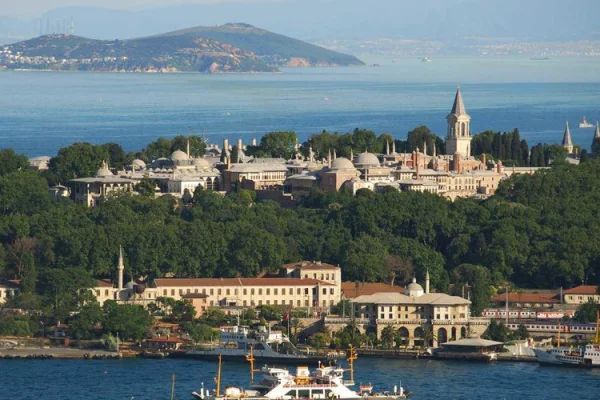Taking a tour among the Most Impressive Ottoman Heritages in Istanbul, in this magical city that is the meeting point of history and civilizations, is like an unforgettable journey into the past. Having served as the capital for three great empires for centuries, Istanbul is home to countless works that reflect the six-century glory of the Ottoman Empire in particular. These works are not just piles of stone and marble, but also living witnesses that carry the aesthetic understanding, power, and spirit of a world empire to the present day. As Joy Tekne Organizasyon, we have prepared this guide to inspire you to discover the cultural riches of this unique city. Come, let's explore the most magnificent of these heritages together and feel the Ottoman spirit of Istanbul deeply.
Topkapi Palace: The Heart of the Empire
Topkapi Palace, which was home to the Ottoman Empire for approximately 400 years, undoubtedly deserves to be at the top of the list. This magnificent complex, built by Sultan Mehmed the Conqueror in 1478, was not just a palace but also a state administration center, an educational institution, and an art academy. The palace is located at the very tip of the Historical Peninsula, at that magnificent point where the Marmara Sea, the Bosphorus, and the Golden Horn intersect. It consists of four main interconnected sections: the first, second, third, and fourth courtyards. In each courtyard, there are structures that served different functions of the empire. From the Tower of Justice to the Chamber of Holy Relics, from the mysterious corridors of the Harem to the unique tiles of the Baghdad and Revan Kiosks, every corner tells visitors a different story. While wandering here, it is impossible not to imagine the sultans' council meetings, accession ceremonies, and holiday greetings. You can crown your day by visiting this historical place by land after a special Bosphorus tour you arrange with Joy Tekne Organizasyon. Objects such as the Spoonmaker's Diamond and the Topkapi Dagger, which are among the palace's priceless collections, display the wealth and splendor of the empire.
Sultanahmet Mosque: Blue Elegance
The Sultanahmet Mosque, one of the first silhouettes that come to mind when thinking of Istanbul, is one of the city's most iconic structures with its six minarets and majestic dome. The mosque, commissioned by Sultan Ahmed I at the beginning of the 17th century to the architect Sedefkâr Mehmed Ağa, is located directly opposite Hagia Sophia, as if challenging it. The more than 20,000 Iznik tiles that adorn the interior of the structure led to it being called the "Blue Mosque" by Westerners due to the dominance of blue, green, and white colors. The immense sense of spaciousness inside the mosque, the play of light filtering through the windows, and the acoustics under the dome give visitors a spiritual peace. Especially at sunset, standing in its courtyard and watching both the Sultanahmet Mosque and the Hagia Sophia opposite is one of the most special moments one can experience in Istanbul. The mosque's complex, with structures like the madrasa, sultan's pavilion, arasta (bazaar), and tomb, also sheds light on the social life of the period. After breathing in this spiritual atmosphere, planning a boat tour with Joy Tekne Organizasyon to view the historical texture from the sea is a great option to experience two different faces of the city on the same day.
Süleymaniye Mosque: Mimar Sinan's Journeyman Work
The Süleymaniye Mosque, commissioned by Suleiman the Magnificent and built by Mimar Sinan, is not just a place of worship but also the product of an architectural genius. This structure, which Mimar Sinan described as "my journeyman work," is located on one of Istanbul's seven hills and dominates the city's skyline. The splendor in the mosque's simplicity reveals Mimar Sinan's aesthetic and static genius. Its main dome, resting on four elephant-foot piers, is supported by semi-domes, creating an incredible sense of integrity and spaciousness in the interior. Its acoustics are so perfect that the imam's voice can be easily heard even from the farthest corner. Every detail, from the soot ink used inside the mosque to the soot room that ensured the soot from the oil lamps collected in a single point, was meticulously thought out. Its complex is like a small city, housing many structures such as madrasas, a darüşşifa (hospital), a hammam, a library, and shops. The tombs of Suleiman the Magnificent and his wife Hürrem Sultan are also located in the mosque's cemetery. Watching the Golden Horn and Bosphorus view from this peaceful hill is perfect for getting away from the chaos of Istanbul. As Joy Tekne Organizasyon, we strongly recommend our guests to visit such spiritual and historical places.
Grand Bazaar: Shopping Inside History
The Grand Bazaar, one of the oldest and largest covered markets in the world, is where Istanbul's commercial heart beats. This historical place, resembling a labyrinth with its more than 60 streets and nearly 4000 shops, began to be established during the reign of Sultan Mehmed the Conqueror and has grown into its current massive structure over time. To get lost here is, in fact, to get lost in history itself. Each street is dedicated to a different craft group; jewelers, carpet sellers, antique dealers, shops selling leather and textile products... The authentic atmosphere of the bazaar, the friendliness of the shopkeepers, and the scent of spices in the air offer visitors a unique experience. The Grand Bazaar should be seen not only for shopping but also for understanding the commercial life, guild system, and social fabric of the Ottoman period. The historical inns, coffeehouses, and fountains inside are proof that the bazaar is a living museum. A handmade piece of jewelry, a silk shawl, or an antique object you buy from here will be a tangible memory of your Istanbul trip. Relaxing in the cool waters of the Bosphorus with Joy Tekne Organizasyon after a tiring day of shopping will recharge your batteries.
Dolmabahçe Palace: The Elegant Face of Westernization
Dolmabahçe Palace, which witnessed the final periods of the Ottoman Empire, is the structure that most clearly shows the changing face of the empire and the influence of Westernization. The palace, built by Sultan Abdülmecid in the mid-19th century, is located on a 600-meter quay at one of the most beautiful spots on the Bosphorus. A mixture of Baroque, Rococo, and Neoclassical architectural styles, Dolmabahçe consists of a single, large main structure, unlike Topkapi Palace. The interior decoration of the palace is dazzling, with furniture brought from Europe, huge crystal chandeliers, and hand-woven Hereke carpets. The 4.5-ton crystal chandelier in the Ceremonial Hall (Muayede Salonu), a gift from Queen Victoria, is one of the largest in the world. The palace consists of three main sections: the Selamlık (official section), the Harem, and the Crown Prince's Suite. The room where Mustafa Kemal Atatürk, the founder of the Republic of Turkey, passed away is also located in this palace and is preserved with great respect. The best place to see this elegant structure, which glides like a swan when viewed from the sea, is undoubtedly a boat tour. On a tour with Joy Tekne Organizasyon, you can witness the full glory of Dolmabahçe Palace from the sea.
Istanbul's Ottoman heritage is not limited to what we have listed. From the mysterious atmosphere of the Basilica Cistern to the spice scents of the Spice Bazaar, from the elegance of the Çırağan and Beylerbeyi Palaces to the spiritual peace of the Eyüp Sultan Mosque, there are countless treasures to be discovered in this city. Every corner, every stone, whispers the story of a six-century-old empire. Discovering this heritage is not just a tourist trip, but also touching the soul of this city, the cradle of civilizations.





